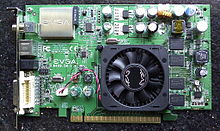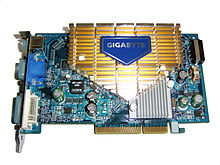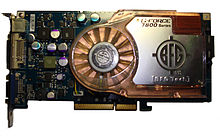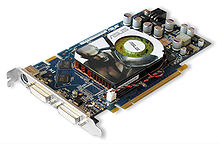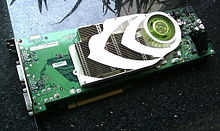- GeForce 7 Series
-
Nvidia GeForce 7 Series Codename(s) G70 (NV47), G71, G72, G73 Release date June 2005 - 2006 Entry-level GPU 7025 (IGP), 7050 (IGP), 7100 (both integrated and discrete variants), 7150 (IGP), 7200, 7300, 7350 Mid-range GPU 7500 (OEM), 7600, 7650 (OEM) High-end GPU 7800, 7900, 7950 Direct3D and shader version DirectX 9.0c with Shader Model 3.0 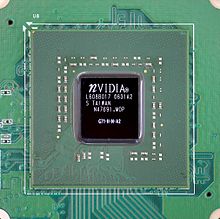 GPU Nvidia G71.
GPU Nvidia G71.
The GeForce 7 Series is the seventh generation of Nvidia's GeForce graphics processing units.
Contents
Features
The following features are common to all models in the GeForce 7 series except the GeForce 7100, which lacks GCAA:
Intellisample 4.0 Technology Scalable Link Interface (SLI) Technology TurboCache Technology Nvidia PureVideo Technology GeForce 7100 Series
The 7100 series was introduced on August 30, 2006 and is based on GeForce 6200 Series architecture. This series supports only PCI Express interface. Only one model, the 7100 GS, is available.[1]
Features
The 7100 series supports all of the standard features common to the GeForce 7 Series provided it is using the ForceWare 91.47 driver or later releases, though it lacks opencl/CUDA support, and its implementation of Intellisample 4.0 lacks GCAA.
However it is important to note that 7100 series does not support technologies such as: high dynamic range rendering (HDR) and UltraShadow II.
GeForce 7100 GS
Although the 7300 LE was originally intended to be the "lowest budget" GPU from the GeForce 7 lineup, the 7100 GS has now taken its place. As it is little more than a revamped version of the GeForce 6200TC, it is designed as a basic PCI-e solution for OEMs to use if the chipset does not have integrated video capabilities. It comes in a PCI Express Graphics Bus and 512MB DDR2 VRAM.
Performance specification
- Graphics Bus: PCI Express
- Memory Interface: 64-bits
- Memory Bandwidth: 5.3 GB/s
- Fill Rate: 1.4 billion pixel/s
- Vertex/s: 263 million
- Memory Type: DDR2 with TC
GeForce 7200 Series
The 7200 series was introduced May 8, 2007 and is based on (G72) architecture. It is designed to offer a low-cost upgrade from integrated graphics solutions. This series supports only PCI Express interface. Only one model, the 7200 GS, is available.[2]
Features
In addition to the standard GeForce 7 Series features, the 7200 series supports the following features:
High dynamic range rendering Technology UltraShadow II Technology CineFX 4.0 Engine However it is important to note that 7200 series does not support Scalable Link Interface (SLI) Technology.
GeForce 7200 GS
The 7200 GS has the same memory speed as the 7300 GS, and the core frequency is the same as the 7300 LE. It has two pixel pipelines. Nvidia stated that the 7200 GS performance is 50% higher than the latest integrated graphics, it's the slowest card of the GeForce 7 Series and of the GeForce 6 Series but supports HDR and Nvidia PureVideo Technology.
Performance Specs:
- Core Clock Speed: 450 MHz
- Memory Clock: 266 MHz (526 MHz effective)
- Memory Bandwidth: 4208 MB/s
- Graphics Bus: PCI Express
- Memory Interface: 64-bits
- Memory Bandwidth: 6.4 GB/s
- Fill Rate: 900 million pixel/s
- Vertex/s: 225 million
- Memory Type: DDR2 with TCC
- Fabrication Process: 90-nm
GeForce 7300 Series
Nvidia designed the 7300 series to be entry level gaming video cards. Currently, 4 models are available: the 7300 GT, the 7300 GS, the 7300 LE, and the 7300 SE.[3]
This series was released to replace the older Geforce 6200 series.
Features
In addition to the standard GeForce 7 Series features, the 7300 series supports following advanced features:
High dynamic range rendering Technology UltraShadow II Technology CineFX 4.0 Engine GeForce 7300 SE
It uses the same core frequency and memory speed as the 7300 LE, and has two vertex and pixel shaders. In many ways, this card is actually inferior to the 7100 GS, although it still retains the HDR support.
Performance Specs:
- Graphics Bus: PCI Express
- Memory Interface: 64-bits
- Memory Bandwidth: 5.2 GB/s
- Fill Rate: 900 million pixel/s
- Vertex/s: 225 million
- Memory Type: DDR2
- Fabrication process: 90-nm
GeForce 7300 LE
The 7300 LE (LE stands for light edition) is a scaled-down version of the 7300 GS. It has DDR2 memory, and a slightly lower core clock speed (450 MHz vs. 550 MHz). It is only available in the PCI Express interface.
Performance Specs:
- Graphics Bus: PCI Express
- Memory Interface: 64-bits
- Memory Bandwidth: 5.2 GB/s
- Fill Rate: 1.8 billion pixel/s
- Vertex/s: 338 million
- Memory Type: DDR2
- Fabrication process: 90-nm
GeForce 7300 GS
Card with the highest core clock speed of the 7300 series. Better performance than the 7300SE/LE.
Performance Specs:
- Graphics Bus: PCI Express
- Memory Interface: 64-bits
- Memory Bandwidth: 6.5 GB/s
- Fill Rate: 2.2 billion pixel/s
- Vertex/s: 413 million
- Memory Type: DDR2
- Fabrication process: 90-nm
GeForce 7300 GT
Card with the 128-bit memory interface and the highest memory bandwidth, but slightly lower 3D vertex rendering.
Performance Specs:
- Graphics Bus: PCI Express and AGP
- Memory Interface: 128-bits
- Memory Bandwidth: 10.7 GB/s
- Fill Rate: 2.8 billion pixel/s
- Vertex/s: 350 million
- Memory Type: DDR2
- Fabrication process: 90-nm
GeForce 7500 Series
GeForce 7500 LE (OEM)
The GeForce 7500 LE is an OEM GPU and is like the 7300 GS based on the G72 core. It has either 128 MB or 256 MB of dedicated video memory, however it also supports TurboCache, giving it up to 512 MB of video memory. It has DDR2 type memory and uses 64-bits memory interface. The card also has 550 MHz core clock speed and 263 MHz or 324 MHz memory clock speed (526 MHz or 648 MHz effective).[4]
Performance Specs:
- Graphics Bus: PCI Express and AGP
- Memory Interface: 64-bits
- Memory Bandwidth: 4.2 GB/s
- Fill Rate: 2.2 billion pixel/s
- Memory Type: DDR2 with TC
GeForce 7600 Series
Nvidia announced immediate availability of the GeForce 7600 series on March 9, 2006. Currently two Models are available and these are GeForce 7600 GT and 7600 GS.[5] This series is available with AGP and PCI-Express interfaces, covering a wide range of market segments.
This series was released to replace the older GeForce 6600 series.
Features
In addition to the standard GeForce 7 Series features, the 7600 series supports following advanced features:
High dynamic range rendering Technology UltraShadow II Technology CineFX 4.0 Engine Extreme HD Technology GeForce 7600 GS
On March 22, 2006, Nvidia announced the immediate availability of the GeForce 7600 GS GPU targeted at the low-mid end. This new GPU assumed the place of the GeForce 6600 GT, which had been around for quite some time.
The AGP version was introduced on July 21, 2006. According to Nvidia, this card is identical to the PCI-e version other than the interface. In addition, the AGP version uses Nvidia's AGP-PCIe bridge chip.
Performance Specs:
- Core Clock Speed: 400 MHz core frequency
- Memory Clock Speed: 400 MHz (800 MHz effective)
- Memory Interface: 128-bits
- Memory Bandwidth: 12.8 GB/s
- Fill Rate: 3.2 billion pixel/s and 4.8 billion texel/s
- Vertex/s: 500 million
- SLI support (Only for the PCIe version)
- Cooling Solution: Passively cooled (Nvidia reference)
- Memory Type: GDDR3 or DDR2
- Fabrication process: 90-nm
Preliminary testing showed that the GeForce 7600 GS outperforms a GeForce 6600 GT and ATI's counterpart, the ATI Radeon X1600 Pro.[6]
GeForce 7600 GT
This is the high-mid range product in the 7 Series family.
Performance Specs:
- Core Clock Speed: 560 MHz
- Memory Clock Speed: 700 MHz (1400 MHz effective)
- Memory Interface: 128-bits
- Memory Bandwidth: 22.4 GB/s memory bandwidth
- Fill Rate:4.48 billion pixel/s and 6.72 billion texel/s
- Vertex/s: 700 million
- SLI Support (for PCI-E Model)
- Shader Power: 12 pixels per cycle
- Memory Type: GDDR3 or DDR2
The 7600 contains all the features of the GeForce 7 family. It was made to provide a Geforce 7 series card to the mass market. Card manufacturer Leadtek introduced an AGP version of the card in August 2006, which was one of the few AGP cards in the market including the new, faster, GDDR3 memory.[7]
GeForce 7650 Series
GeForce 7650 GS (OEM)
The GeForce 7650GS was limited to a few OEM cards only. Not much is known about this card, other than that it uses the 80 nm process.
Performance Specs:
These specifications are based on a card manufactured by Asus.[8] There might be differences between OEM cards.
- Core Clock Speed: 450 MHz core frequency
- Memory Clock Speed: 400 MHz (800 MHz effective)
- Memory Interface: 128-bits
- Memory Bandwidth: 12.8 GB/s
- Fill Rate: 3.6 GPixel/s and 4.8 GTexel/s
- Cooling Solution: Passively cooled, or Small Heatsink and Fan
- Memory Type: DDR2
A card manufactured by MSI gives the same specification, however it has a 4.8 GTexel/s rating.[9]
GeForce 7800 Series
The 7800 series was designed to deliver exceptional performance and was targeted towards high-end market segment. This series was discontinued and replaced with the 7900 series in early 2006.
A total of 4 models were available: GeForce 7800 GTX 512, GeForce 7800 GTX, GeForce 7800 GT, and GeForce 7800 GS.[10]
Features
In addition to the standard GeForce 7 Series features, the 7800 series supports following advanced features:
High dynamic range rendering Technology UltraShadow II Technology CineFX 4.0 Engine GeForce 7800 GT
The GeForce 7800 GT is the second GPU in the series, launched on August 11, 2005 with immediate retail availability. It has 20 pixel pipelines, 7 vertex shaders, 16 ROPs and a 400 MHz core clock, 500 MHz memory clock (1 GHz effective) using GDDR3 memory.
The GeForce 7800 GT had been introduced as a more affordable alternative to the 7800 GTX. At the time it was considered the performance/cost champion of video cards.
GeForce 7800 GS AGP
On February 2, 2006, Nvidia announced the 7800 GS as the first AGP video card in the GeForce 7 series lineup, an AGP version of the high-end GeForce 7 Series.[11]
This card was promoted by several hardware enthusiasts as "the last high-ended AGP card in existence". It has 16 pixel shader units instead of the 20 that the 7800 GT has, but still benefits from the optimizations of the other 7-series GPUs enjoy. Clock speeds are 375 MHz for the GPU and 1200 MHz for the (GDDR3) memory. According to all benchmark tests, the performance of this card is faster than the GeForce 6800 GT and GeForce 6800 Ultra. Different vendors may deviate from the stated specification. It serves to provide a great upgrade path for those with high-end AGP systems who don't want to switch to a new high-end PCI-Express system.[12] There was a special "Golden Sample" release from Gainward that was called "7800 GS+" or officially "Bliss 7800 GS 512 MB GS+" that had default clock speeds of 450 MHz core and 1250 MHz memory. Unlike a standard 7800 GS, the 7800 GS+ actually used a 7900 GT GPU that had the full 24 pixel shaders instead of the regular 16 pixel shaders that are normally found on a 7800 GS video card.
Gainward had previously released a "Bliss 7800 GS 512MB GS" card that was based on a 7800 GT but utilized the AGP bus. Its external appearance and name make it nearly indistinguishable from the 7900 GT-based Bliss 7800 GS 512MB GS+. Leadtek produced a similar card with 256MB memory.
In late 2006 Gainward released a third '7800 GS' card with 20 pixel shaders running at 500 MHz core and 1400 MHz memory called the "BLISS GS-GLH". This card is also based on the 7900 GS core.
There are no after-market cooling systems for the 7800 GS, stock cooling in the GeForce 7800 GS AGP is adequate. The board layout is radically different from other GeForce 7 boards so no universal aftermarket coolers would fit without significant modification to their mounting mechanisms.
GeForce 7800 GTX
The GeForce 7800 GTX (codenamed G70, and previously NV47) was the first GPU in the series, launched on June 22, 2005 with immediate retail availability. The GeForce 7800 GTX supported the highest specification DirectX 9 vertex and pixel shaders, at the time: Version 3.0. It was natively a PCI Express chip. SLI support had been retained and improved from the previous generation.
According to PC World, the 7800 GTX was "one of the most complex processors ever designed". The GPU had 302 million transistors (the Athlon 64 X2 4800+ CPU has 233.2 million transistors), along with 24 pixel and 8 vertex shaders.[13] It was succeeded by the 7900 GTX on March 9, 2006.
GeForce 7800 GTX 512
The 512 MB version of the GeForce 7800 GTX was released on November 14, 2005. The card features more than simply an increased frame buffer from 256 MB to 512 MB. The card features a much improved core clock speed of 550 MHz vs. 430 MHz (27.9% increase) and fast 1.1 ns GDDR3 memory clocked at 1.7 GHz vs. 1.2 GHz (41.7% increase), when compared to the original version. Like ATI's X1800 XT, the addition of another 256 MB of memory, and to a lesser extent, the increased clock speeds, have raised the heat and power output significantly. To combat this, the GeForce 7800 GTX 512 sports a much larger yet quieter dual slot cooling solution when compared to the original 256 MB version.[14]
- Performance Specs
- Core Clock Speed: 550 MHz
- Memory Interface: 256-bits
- Memory Bandwidth: 54.4 GB/s
- Fill Rate: 8.8 billion pixel/s, 13.2 billion texel/s
- Vertex/s: 1100 millions
- Shader Power: 24 pixels per clock
- Memory Type: GDDR3
GeForce 7900 Series
Nvidia officially announced availability of the GeForce 7900 series on March 9, 2006.[15]
Nvidia's 7900 series is a product refresh and not a new generation of Nvidia's GPU, running at 650 MHz. Officially this series is meant to support only PCI Express Interface but some companies released AGP versions.
A total of 5 models have been developed and are available: 7900 GX2, 7900 GTX, 7900 GT, 7900 GTO and 7900 GS.
Features
In addition to the standard GeForce 7 Series features, the 7900 series supports following advanced features:
High dynamic range rendering Technology UltraShadow II Technology CineFX 4.0 Engine Extreme HD Technology GeForce 7900 GS
Introduced during the fall of 2006, At a MSRP of US$199,[16] the 7900 GS filled the gap between the mid-end GeForce 7600 GT and the high-end GeForce 7900 GT. The card was unofficially launched August 23 by woot! as a white box OEM. However, the product's company, MSI, made claims that these cards were stolen from MSI during transportation and sold to woot!.[17] The referenced MSI customer notice has been changed to remove explicit references to woot!. As of March 2007, Nvidia had discontinued production of a number of GeForce 6 and 7 series products, including the 7900 GS.
The GeForce 7900 GS has 20 pixel processors, 7 vertex processors, 256-bits memory bus, and comes clocked at approximately 450 MHz/1320 MHz for core/memory, which should provide slightly lower performance than the 7900 GT. The GeForce 7900 GS is powered by the latest graphics chip code-named G71, thus, shares the same advantages as the G71 did over its immediate predecessor G70: dual-link DVI outputs, reduced power consumption, higher performance.[18]
- Performance Specs
- Core Clock Speed: 450 MHz
- Memory Interface: 256-bits
- Memory Bandwidth: 42.2 GB/s memory bandwidth
- Fill Rate: 9 Billion pixel/s
- Vertex/s: 822.5 Million
- Shader Power: 20 pixels per clock
- SLI Support (PCI-E model only)
- Memory Type: GDDR3
NOTE: XFX has developed AGP versions of this card as well.[19]
GeForce 7900 GT
This video card was released on March 9, 2006. Like the 7900 GTX, it uses the G71 GPU that is produced at 90 nm. It too offers all the features of the 7800 series as well as an attractive performance-to-price ratio.
Performance Specs:
- Core Clock Speed: 450 MHz
- Memory Interface: 256-bits
- Memory Bandwidth: 42.2 GB/s memory bandwidth
- Fill Rate: 10.8 Billion pixel/s
- Vertex/s: 940 Million
- Shader Power: 24 pixels per clock
- Memory Type: GDDR3
GeForce 7900 GTX
The GeForce 7900 GTX is a 90 nm produced G70 (named G71) and features all the same features of the 7800 GTX but is built upon the smaller manufacturing process. Due to shortages of memory modules for the 512 MB GTX, more readily available 1600 MHz memory was used.
- Performance Specs
- Core Clock Speed: 650 MHz
- Memory Interface: 256-bits
- Memory Bandwidth: 51.2 GB/s memory bandwidth
- Fill Rate: 15.6 Billion pixel/s
- Vertex/s: 1.4 Billion
- Shader Power: 24 pixels per clock
- Memory Type: GDDR3
GeForce 7900 GTO
The 7900 GTO is a close cousin of the 7900 GTX.[20] The GTO first arrived at a handful of retailers around October 1, 2006. At the time of launch, GTO boards sold for around US$250, compared to the 7900 GTX boards that cost in excess of $400 at the time. The GTO was essentially identical to the GTX, with the exception that it lacked HDCP and VIVO support, had underclocked memory running at 1320 MHz, and used tighter memory timings. Other than that, the two boards were identical: same PCB, same cooler, same GPU. The GTO used extremely fast 1.1ns Samsung BJ11 GDDR3 memory running at 1.8V, as opposed to the 2.1V it is rated at. Clock speeds on the two cards are identical, at 650 MHz. At stock memory speeds, most comparisons found the GTO to lag behind the GTX by roughly a 5-10% margin.
The majority of owners find that their GTO will overclock to 1600 MHz memory speeds, despite the under-volted RAM. Many flash their GTO to a GTX BIOS to officially make it a GTX. GTO owners having trouble reaching GTX speeds with BIOS version 5.71.22.39.13 or newer are advised to simply flash to an older BIOS version such as 5.71.22.39.08, this seems to solve overclocking problems for most users.
The GTO was an extremely popular card among enthusiasts as it offered near GTX performance at a considerably lower price. It was a limited production card aimed at cleaning out G70 inventories before the release of the G80, and only spent about a month in retail channels before selling out.
GeForce 7900 GX2
The GeForce 7900 GX2 is two videocards stacked to fit as a dual slot solution.[21] This is not like products such as the ASUS Dual GeForce 7800 GT or nVidia's own 7950 GX2, where two GPUs are on the same card. This enables quad-SLI on two PCI Express x16 slots. Other OEM companies have access to the GX2 and it is now available from numerous vendors.
The card features a 500 MHz GPU and 1200 MHz effective RAM speed. Although the power of the GX2 is less than the 7900 GTX, each card is more powerful than the 7900 GT.
Many issues in this implementation of a dual-GPU unit convinced Nvidia to restrict its sale to OEM companies. The card is extremely long, with only the largest e-ATX cases being able to hold it. Two of the cards operating in quad-SLI also required extremely well designed airflow to function, and demanded a 1000 watt power supply unit.
GeForce 7950 Series
GeForce 7950 Series is the last addition in the GeForce 7 series. Officially this series was meant to only support PCI Express interface but some companies have released AGP versions as well.
Two models are available: 7950 GT and 7950 GX2.[22]
Features
In addition to the standard GeForce 7 Series features, the 7950 series supports following advanced features:
High dynamic range rendering Technology UltraShadow II Technology CineFX 4.0 Engine Extreme HD Technology GeForce 7950 GT
On 14 September 2006 Nvidia released the 7950GT. Announced with a 550 MHz core clock, 700 MHz (1400 MHz effective) memory clock, 24 pixel shader units, standard configurations come equipped with both 512 MB GDDR3 memory and HDCP support. At an introductory price of US$300, the GeForce 7950 GT replaces the older GeForce 7900 GT and improves performance: the GeForce 7950 GT has a fillrate of 13,200 Megatexels/s and a memory bandwidth of 44.8 GB/s (versus 10800 Megatexels/s and 940 Megavertices/s for the 7900 GT).
- Performance Specs
- Memory Interface: 256-bits
- Memory Bandwidth: 44.8 GB/s memory bandwidth
- Fill Rate: 13.2 Billion pixel/s
- Vertex/s: 1.1 Billion
- Shader Power: 24 pixels per clock
- SLI Support (PCI-E model only)
- Memory Type: GDDR3
NOTE: XFX has developed and released AGP versions of this card.[23]
GeForce 7950 GX2
This is essentially a dual-GPU video card that takes up only a single PCIe x16 slot, allowing for 4 GPUs to run with only two PCIe x16 slots, in standard SLI motherboards. Unlike the 7900 GX2 before it, this version is available to consumers directly.[24]
The 7950 GX2 was released to retail on June 5, 2006, and shares similar specs to the GeForce 7900 GX2, with 500 MHz GPU clock, and 1200 MHz effective RAM speed. 512 MB of memory per GPU, for a total of 1 GB, however total performance is more in line with 512 MB since each GPU can only access its own memory and not the memory of the other one. It does not offer any advantages over single-GPU cards with 512 MB, memory wise.
This card is designed for the DIY market; it addresses many problems which the previous 7900 GX2 had suffered from, such as noise, size, power consumption, and price. The 7950 GX2 requires only a single PCIe power connector, in contrast to the twin-connectors of its predecessor; technically, this is understandable, as there is no need for a ring bus configuration – frames need only be passed on to the primary GPU. It is much shorter, fitting easily in the same space as a 7900 GTX. Lesser board layout and the removal of cooling vents on the bracket have greatly declined cooling, allowing the fans to run at a lower speed, thereby lowering noise. As of September 2006, the board can be found for $299, half the cost of a 7900 GX2.
According to some review sites (such as Tom's Hardware - see above), a single 7950GX2 draws less power than a single ATI Radeon X1900 XT – some consider this an amazing feat considering the GX2 employs a pair of GPUs, when the Radeon uses only one. Other review sites say that a GX2 is quieter than the aforementioned Radeon,[25] despite the GX2 boasting a pair of identical GPU coolers – however 'loudness' is highly subjective without the proper tools and testing conditions. If true, this would make a pair of GX2 cards cooler, quieter, and less power hungry than a pair of X1900 XT cards in CrossFire. However, there is no appreciable performance gain from pairing two 7950 GX2 cards in most applications, while dual X1900 XT configurations see large performance boosts in CrossFire mode.[citation needed]
- Performance Specs
- Memory Interface: 2x 256-bits
- Memory Bandwidth: 76.8 GB/s memory bandwidth
- Fill Rate: 24 Billion pixel/s
- Vertex/s: 2 Billion
- Shader Power: 48 pixels per clock
- Memory Type: GDDR3
On August 9, 2006, Nvidia released initial ForceWare 91.45 drivers for Windows 2000 and XP that support Quad SLI.[26] The Quad SLI support was soon merged in with the normal WHQL driver package, when ForceWare 91.47 drivers was released on October 16, 2006.[27]
GeForce Go 7 Series
Nvidia has not only targeted the desktop market but also the notebook market with the GeForce 7 series.[28]
Features
In addition to the standard GeForce 7 Series features, the GeForce Go 7 series supports following advanced features:
Extreme HD Technology PowerMizer Mobile Technology MXM Graphics Module Technology High dynamic range rendering Technology UltraShadow II Technology CineFX 4.0 Engine Nvidia PureVideo HD Technology - The GeForce Go 7 GPU series line-up
The GeForce Go 7 GPU series line-up consists of following models:
- GeForce Go 7950
- GeForce Go 7900
- GeForce Go 7800
- GeForce Go 7700
- GeForce Go 7600
- GeForce Go 7400
- GeForce Go 7300
- GeForce Go 7200
- GeForce Go 7150
- GeForce Go 7000
See also
- Comparison of Nvidia graphics processing units (GPUs only shown by general category, i.e. NV40 NV30)
- GeForce 6 Series
- GeForce 8 Series
- PCI Express
- PlayStation 3
References
- ^ "GeForce 7100 series". NVIDIA.com. http://www.nvidia.com/page/geforce_7100.html. Retrieved 2008-06-15.
- ^ "GeForce 7200 series". NVIDIA.com. http://www.nvidia.com/page/geforce_7200.html. Retrieved 2008-06-15.
- ^ "GeForce 7300 series". NVIDIA.com. http://www.nvidia.com/page/geforce_7300.html. Retrieved 2008-06-15.
- ^ "GeForce 7500 LE GPU-Z validation". techPowerUp. January 7, 2008. http://www.techpowerup.com/gpuz/5yfhx/. Retrieved 2008-01-07.
- ^ "GeForce 7600 series". NVIDIA.com. http://www.nvidia.com/page/geforce_7600.html. Retrieved 2008-06-15.
- ^ Vincent Chang (22 March 2006). "MSI NX7600GS-T2D256EH Review". HardwareZone. Archived from the original on February 8, 2008. http://web.archive.org/web/20080208200225/http%3A//www.hardwarezone.com/articles/view.php%3Fcid%3D1%26id%3D1856. Retrieved 2008-06-15.
- ^ Vincent Chang (28 August 2006). "Leadtek WinFast A7600 GT TDH Review". HardwareZone. Archived from the original on March 29, 2008. http://web.archive.org/web/20080329093528/http%3A//www.hardwarezone.com/articles/view.php%3Fcid%3D3%26id%3D2031. Retrieved 2008-06-15.
- ^ "GeForce 7650 GS GPU-Z validation with ASUS card". techPowerUp. February 29, 2008. http://www.techpowerup.com/gpuz/ha99a/. Retrieved 2008-02-29.
- ^ "GeForce 7650 GS GPU-Z validation with MSI card". techPowerUp. August 4, 2008. http://www.techpowerup.com/gpuz/2dxef/. Retrieved 2008-08-04.
- ^ "GeForce 7800 series". NVIDIA.com. http://www.nvidia.com/page/geforce_7800.html. Retrieved 2008-06-15.
- ^ "AGP 7800 GS revealed" (Press release). NVIDIA. February 2, 2006. http://www.nvidia.com/object/IO_29168.html. Retrieved 2008-06-15.
- ^ Derek Wilson (February 2, 2006). "Nvidia's AGP Only GeForce 7800 GS". AnandTech. http://www.anandtech.com/video/showdoc.aspx?i=2686. Retrieved 2008-06-15.
- ^ Eric Dahl (June 22, 2005). "GeForce 7800 GTX Sets Gaming Speed Records". PC World. http://www.pcworld.com/article/id,121548-page,1/article.html. Retrieved 2008-06-15.
- ^ Derek Wilson (14 November 2005). "Nvidia GeForce 7800 GTX 512: More Than Just More Memory". AnandTech. http://www.anandtech.com/video/showdoc.aspx?i=2607. Retrieved 2008-06-15.
- ^ "GeForce 7900 series". NVIDIA.com. http://www.nvidia.com/page/geforce_7900.html. Retrieved 2008-06-15.
- ^ Anton Shilov (12 August 2006). "Nvidia Plans to Sell GeForce 7900 GS in Retail.". X-bit labs. http://www.xbitlabs.com/news/video/display/20060812130416.html. Retrieved 2008-06-15.
- ^ "Important MSI Customer Notice about stolen 7900GS video cards.". MSI. 20 August 2006. Archived from the original on April 30, 2008. http://web.archive.org/web/20080430072322/http%3A//www.msicomputer.com/msiforms2/stolen.asp. Retrieved 2008-06-15.
- ^ Anton Shilov (15 May 2006). "Dell Touts GeForce 7900 GS Graphics Card". X-bit labs. http://www.xbitlabs.com/news/video/display/20060515072315.html. Retrieved 2008-06-15.
- ^ "XFX GeForce 7900 GS AGP 8X 256MB DDR3". http://www.xfxforce.com/web/product/listConfigurationDetails.jspa?series=GeForce%26trade%3B+7900&productConfigurationId=1006184[dead link]
- ^ Marc (September 8, 2006). "Specifications of the GeForce 7900 GTO". BeHardware. http://www.behardware.com/news/8340/specifications-of-the-geforce-7900-gto.html. Retrieved 2008-06-15.
- ^ "Nvidia GeForce 7900 GX2 1024 MB Details". http://www.beyond3d.com/resources/board/320
- ^ "GeForce 7950 series". NVIDIA.com. http://www.nvidia.com/page/geforce_7950.html. Retrieved 2008-06-15.
- ^ "XFX GeForce 7950 GT AGP 8X 512MB DDR3". http://www.xfxforce.com/web/product/listConfigurations.jspa?seriesId=185563&productId=638284[dead link]
- ^ Darren E. Polkowski (June 5, 2006). "GeForce 7950 GX2 - SLI on a Single Card". Tom's Hardware. http://www.tomshardware.com/reviews/geforce-7950-gx2,1264.html. Retrieved 2008-06-15.
- ^ Tim Smalley (6 June 2006). "Nvidia GeForce 7950 GX2". bit-tech. http://www.bit-tech.net/hardware/2006/06/06/nvidia_geforce_7950_gx2/11. Retrieved 2008-06-15.
- ^ "Nvidia ForceWare 91.45 driver". http://www.nvidia.com/object/winxp_2k_91.45.html
- ^ "Nvidia ForceWare 91.47 driver". http://www.nvidia.com/object/winxp_2k_91.47.html
- ^ "GeForce 7 GO Series". NVIDIA.com. http://www.nvidia.com/page/geforcego7.html. Retrieved 2008-06-15.
External links
- Nvidia Website
- GeForce 7 Series Product Overview
- Final Windows XP GeForce Release 179.48 drivers for Notebooks
- Final Windows Vista/Windows 7 GeForce Release 179.48 drivers for Notebooks
- techPowerUp! GPU Database
Nvidia Graphics processing units Early chipsetsRIVA seriesGeForce 256 · GeForce 2 · GeForce 3 · GeForce 4 · GeForce 5 · GeForce 6 · GeForce 7 · GeForce 8 · GeForce 9 · GeForce 100 · GeForce 200 · GeForce 300 · GeForce 400 · GeForce 500Other seriesTechnologiesMotherboard chipsets GeForce SeriesnForce SeriesnForce 220/415/420 · nForce2 · nForce3 · nForce4 · nForce 500 · nForce 600 · nForce 700 · nForce 900TechnologiesOther products Project DenverBridge chipsHandheldSoftwareAcquisitionsKey people Jen-Hsun Huang · Chris Malachowsky · Curtis Priem · David Kirk · Debora Shoquist · Dr. Ranga Jayaraman · Jonah M. AlbenCategories:- 2005 introductions
- Nvidia
- Video cards
Wikimedia Foundation. 2010.

